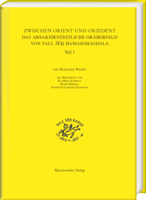|
|
more titles of the subject:
Download:
Im Grabungsabschnitt „Mittlere Unterstadt II“ sind insgesamt 732 Grabkomplexe eines parthisch-römischen Gräberfeldes (Friedhofs) ausgegraben worden. 313 von ihnen sind in BATSH 5 publiziert worden. Die verbleibenden 419 Grabkomplexe wurden In diesem Band vorgelegt und ausgewertet. Die anthropologischen Untersuchungen der Individuen aus den 419 Grabkomplexen und eine anthropologische Bewertung des Gesamtbefundes ist von H. Hornig in BATSH 13-1 vorgelegt worden.
Nach einer Einleitung zur geographischen Lage und zur Topographie des Fundortes (Kap. I) erfolgt eine Klassifizierung der 419 Gräber in Kap. II (und im Katalog) und der Funde in Kap. III. Unter Einbeziehung der 313 vorab publizierten Gräber widmet sich Kap. IV der Chronologie des gesamten Gräberfeldes: Die interne Stratigraphie umfasst insgesamt 86 vertikale Grabsequenzen. Unter Anwendung der Methode der Seriation können vier Zeitstufen generiert werden, in denen sich die Belegung des Gräberfeldes vom Ende des 3. Jahrhunderts v. Chr. bis ins 3. Jahrhundert n. Chr. vollzog. Auf dieser Grundlage erfolgt eine Rekonstruktion des Totenrituals in ihrer zeitlichen Differenzierung (Kap. V). Abschließend werden eine kulturhistorische Einordnung und eine überregionale Bewertung des Gräberfeldes vorgenommen (Kap. VI). Zusätzlich werden die Befunde der fünfzig im Grabungsabschnitt „Nordost Ecke der Unterstadt II“ ausgegrabenen zeitgleichen Grabkomplexe in zwei Beiträge von K. Schmitt und H. Hornig vorgelegt. Die Ergebnisse der Ausgrabung der zu dem Gräberfeld gehörenden Siedlung auf der Zitadelle sind in BATSH 2 publiziert, so dass die Vorlage und Bewertung der Ausgrabungsbefunde der spät hellenistischen und parthisch-römischen Zeit mit diesem Band abgeschlossen wird. Mit Blick auf die bekannten eher dürftigen schriftlichen und materiellen Zeugnissen trägt das Ensemble „Stadt und Gräberfeld von Magdala“ erheblich zu unser Kenntnis über parthisch-römische Berührungen im umkämpften Grenzbereich am Habur und am Mittleren Euphrat bei. 732 graves of a Parthian-Roman cemetery were excavated in the excavation unit „Central Lower Town II”. 313 of them have been published in BATSH 5. The remaining 419 are documented and studied in this volume. The anthropological investigation of the individuals of the 419 graves and an assessment of the complete anthropological evidence has been presented in BATSH 13-1 by H. Hornig. After an introduction to the geographical situation and to the topography of the site (chap. I) a classification of the 419 graves is presented in chap. II (and in the catalogue) and of the grave goods in chap. III. Considering the previously published 313 graves chap. IV is concerned with the chronology of the whole grave ground: 86 vertical sequences of graves have been observed; applying the method of seriation four intervals are generated in which the grave ground was occupied from the end of the 3rd century BC to the beginning of the 3rd century AD. On this basis, the rituals in connection with the disposal of the dead are reconstructed and discussed in their temporal differentiations (chap. V). Finally, a cultural-historical appraisal and a super-regional assessment of the grave ground are presented in chap. VI. In addition, this volume includes two contributions on the fifty contemporary graves excavated in the excavation unit “Northeast Corner of the Lower Town II” by K. Schmitt and their anthropological data by H. Hornig. Corresponding to the excavated levels of the contemporary settlement on the citadel/Tell published in BATSH 2 this volume terminates the presentation and evaluation of the ensemble “town and cemetery of Magdala”. In view of the known rather scanty textual and material sources this archaeological evidence contributes to our knowledge about the Parthian-Roman contacts in this contested border region of the Habur and the Middle Euphrates. |




